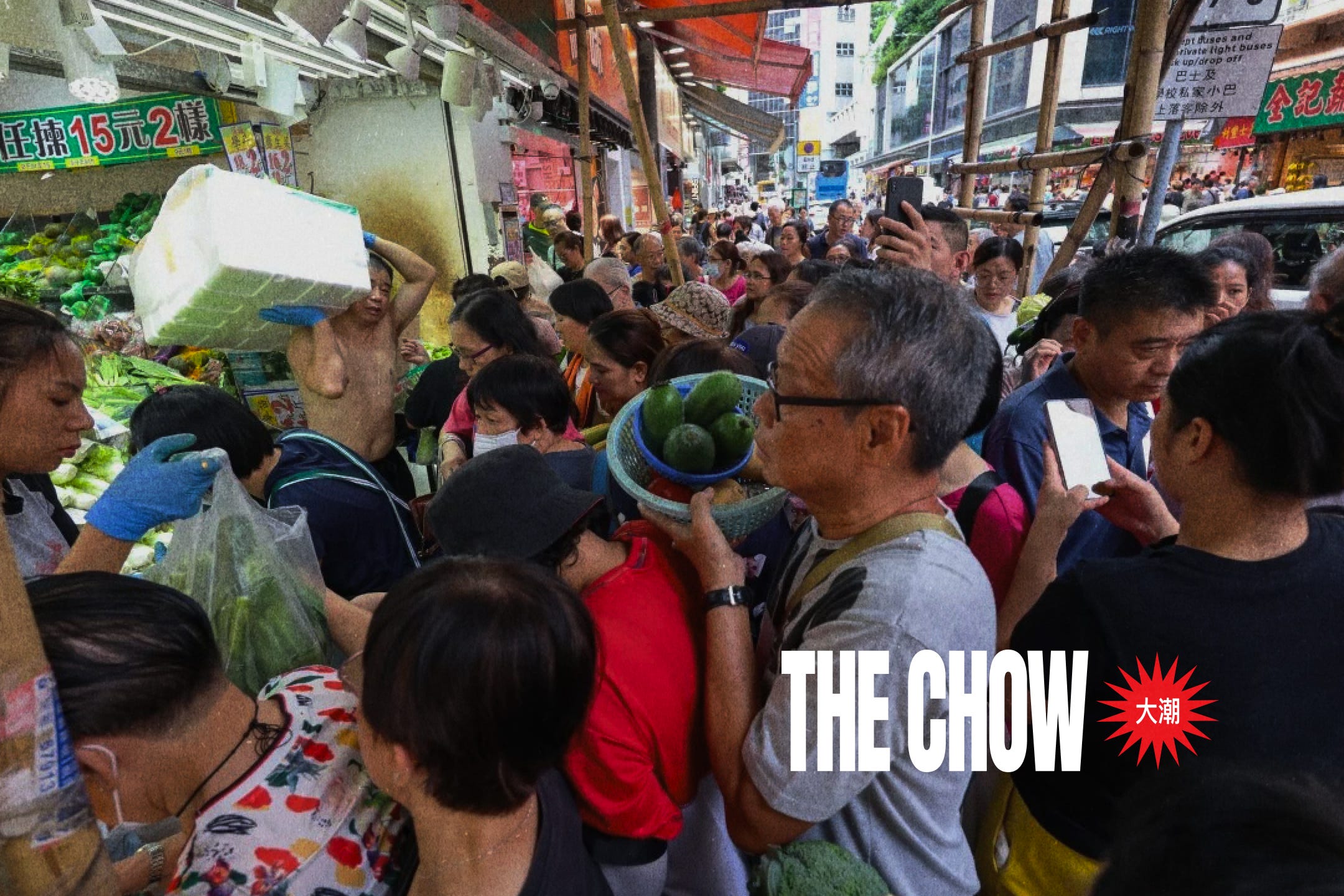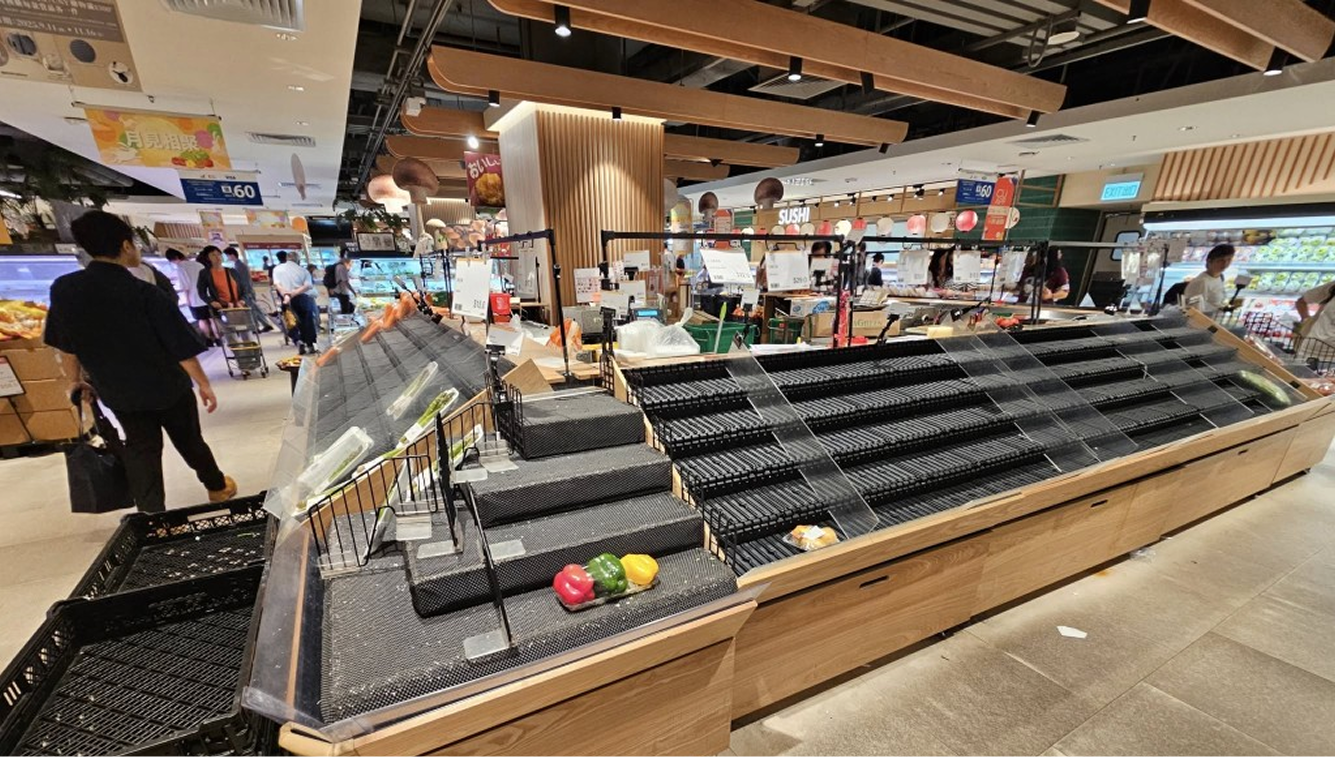Grocery Shopping in the Apocalypse
What can pre-typhoon consumption in Hong Kong teach us about the end of the world?
It’s on a Monday in late September when Typhoon Ragasa, the strongest tropical cyclone on record in 2025, inches towards Hong Kong. The air is still calm and the storm is still one day’s worth of travel away, but the local butchers in Sai Wan Ho market are in a frenzy. Shoppers are buying extra—stockpiling in preparation for the storm—and the meat is being sliced twice as fast.
Further along the street, vegetable sellers pass plastic bags filled with choy sum. A crowd of twenty packs the store’s entrance. “You only see this many people sometimes during the Lunar New Year,” a store owner tells the South China Morning Post. Tonight, supply will finish long before the sun can set. All shops are closing early.
Elsewhere, at grocery store chains like Wellcome or Marketplace, shopping carts stuffed with toilet paper squeeze in queues lined towards cash registers. By 7pm, there was nothing left to buy: all the fruits and eggs and meat and vegetables had been cleared from the shelves. You had run out of time.
You never have to look at the weather app to know when a typhoon is inching towards Southern China. The wet markets and the grocery stores in Hong Kong will tell you that much.
Days before its arrival to the city, Ragasa had left a trail of death and destruction behind—17 people were killed in Taiwan, while damages to cities in the Philippines are projected to cost millions. Despite knowing what sort of force of nature is looming ahead, the scene at a Hong Kong market or grocery store plays out in relative calm. Everyone is quiet despite the destruction that might ensue. In one video shared by CNN, a store is crowded and shelves are completely empty but you barely hear as much of a whisper. No one is lashing or crying out. But people are purchasing food and toilet paper as if the end of the world was nigh.
Anyone who’s spent a summer in Hong Kong knows that pre-storm panic buying is a city-wide ritual during monsoon season. Typhoons happen multiple times a year, and somehow when a storm is arriving, the ritualistic stockpiling and under-expressed panic make these events look—paradoxically—as novel as they are ordinary.
Why is panic buying so ritualistic in a city like Hong Kong? In an interview for another piece, a leading creative strategist in the city offered me this explanation: “Chinese culture has always been [about] protecting your family, your assets, and saving more than you spend. Everything is to preserve for a better living—even the practice of stocking up and making sure you have enough resources when the world falls apart.”
But I find these explanations on Chinese consumer behavior lazy and one dimensional. And they’re especially uninspiring if they often come from Chinese people themselves (in my experience, they often do).
Instead, I think that widespread, ritualistic panic buying better reflects something more unique to the city: Hong Kong’s conflicting relationship with the environment. The East Asian financial hub might be known for its colorful skyline with the most skyscrapers in the world, but when you consider its geography, it’s a miracle that so much of this was even built.
Hong Kong is a fragmented collection of islands—approximately 236 to 263, as estimates vary—mapped into a single territory. The territory’s land is often hilly to mountainous, with steep slopes that often drop sharply into the sea. All this to say that the city is not conducive to building: Developed land only occupies less than a quarter of all land area in Hong Kong.
Then how did one of the world’s leading financial hubs get built on a mountainous archipelago? It would’ve been an impossibility if not for human intervention. Much of Hong Kong is built on reclaimed land. As early as 1841, when the British first arrived in Hong Kong, one of their first orders of business was to extend the shoreline 130 meters beyond present-day Queen’s Road (the city’s main street). Later, as Cathay Magazine reports, another ambitious land reclamation project took place towards the turn of the 20th century, when Armenian businessman Catchick Paul Chater “hatched a plan to reclaim 24 hectares of land” in the middle of the city’s central business district. When the project finished in 1900, the new land became Hong Kong’s “most prized real estate,” housing the prestigious Hong Kong Club and the Supreme Court. A total of 10 other land reclamation projects have taken place in the city since then.
Hong Kong is skyscrapers built on land built on water—a brute-force adaptation to the environment, not in symbiotic relationship with nature but in building with concrete at scale.
Even further away from the shoreline, that ethos still shapes the city. Hong Kong is an “unfathomable spaghetti” of flyovers, pedestrian bridges, tunnels, escalators, and walkways. These structures almost function like connective tissue for a parallel, man-made environment, facilitating movement around the city from hotels to train stations to malls to carparks, and safeguarding pedestrians from elemental threats at the street-level, whether that’s the exhaust of cars or the smells of trash and sewage. You can almost never use Google Maps here, because every route will involve stairs and walkways that the app struggles to display in 2D.
As anthropologist Tim Choy notes in Ecologies of Comparison, Hong Kong is “designed to get off the ground—into the air, and out of it.” Walking around the city, Choy recalls: “My grandmother and I got lost once in these walkways. I remember how she pointed down to the street. There, she said, that’s where I want to go. How do we get there? We never made it—we were lost in the flyovers.”
Hong Kong is a “city without ground,” according to a recent book by architects Adam Frampton, Jonathan D. Solomon, and Clara Wong. Or, Hong Kong is a “floating city,” as the Chinese author Xi Xi writes. In any case, some of the most oft-used metaphors of the city involve transcending the earthly plane—not existing or integrating within the environment but instead in a brand new world of its own making. It is a century-and-a-half-long project to escape from the atmosphere.
In a city where the environment is constantly adapted to with brute force, destructive, large-scale typhoons almost become routine. When the Hong Kong consumer engages in panic buying, the ritualistic form hints at another truth: that for the average person in the city, being at odds with nature is a banal, boring fact of life.
To my knowledge, Pacific Rim (2013) is one of few blockbusters where the entire world unites in an all-out war against the Kaiju—giant beasts from Japanese fiction. The size of the monsters makes the fragility of human flesh feel so visceral—in face of them, symbols of large-scale forces of nature, humanity is powerless. Fittingly, Pacific Rim’s humanity-is-at-stake-level war against the monsters has its final showdown in Hong Kong, where the man-made is constantly wrestling with the natural.
Hong Kong’s prevalence in other science fiction works—Blade Runner (1982), Skyscraper (2018), Godzilla vs. Kong (2021) to name a few other examples—points to how the city’s often pondered as the beginning of The End of the World. But unlike these films’ large-scale spectacles of destruction, there’s little drama in the way that the Hong Kong consumer reacts to cataclysmic events in real life. Natural disasters like typhoons are treated with routine and ritual.
What can they teach us about the apocalypse? What can they teach us about a world where climate catastrophe looms ahead? Should an apocalypse arrive, it probably will not have gigantic Kaijus to fight; it will probably be understated, unremarkable, paced slowly like an indie film you don’t understand. We arrived at a world with rising temperatures and poisoned water reserves without drama, fear, or terror. An apocalypse will be similar: we might clear the shelves, leaving markets and grocery stores empty and barren, stockpiling in preparation as the panic-buyer might, but it will be as banal and boring as the everyday.







Impressive as always!!!🤎🤎